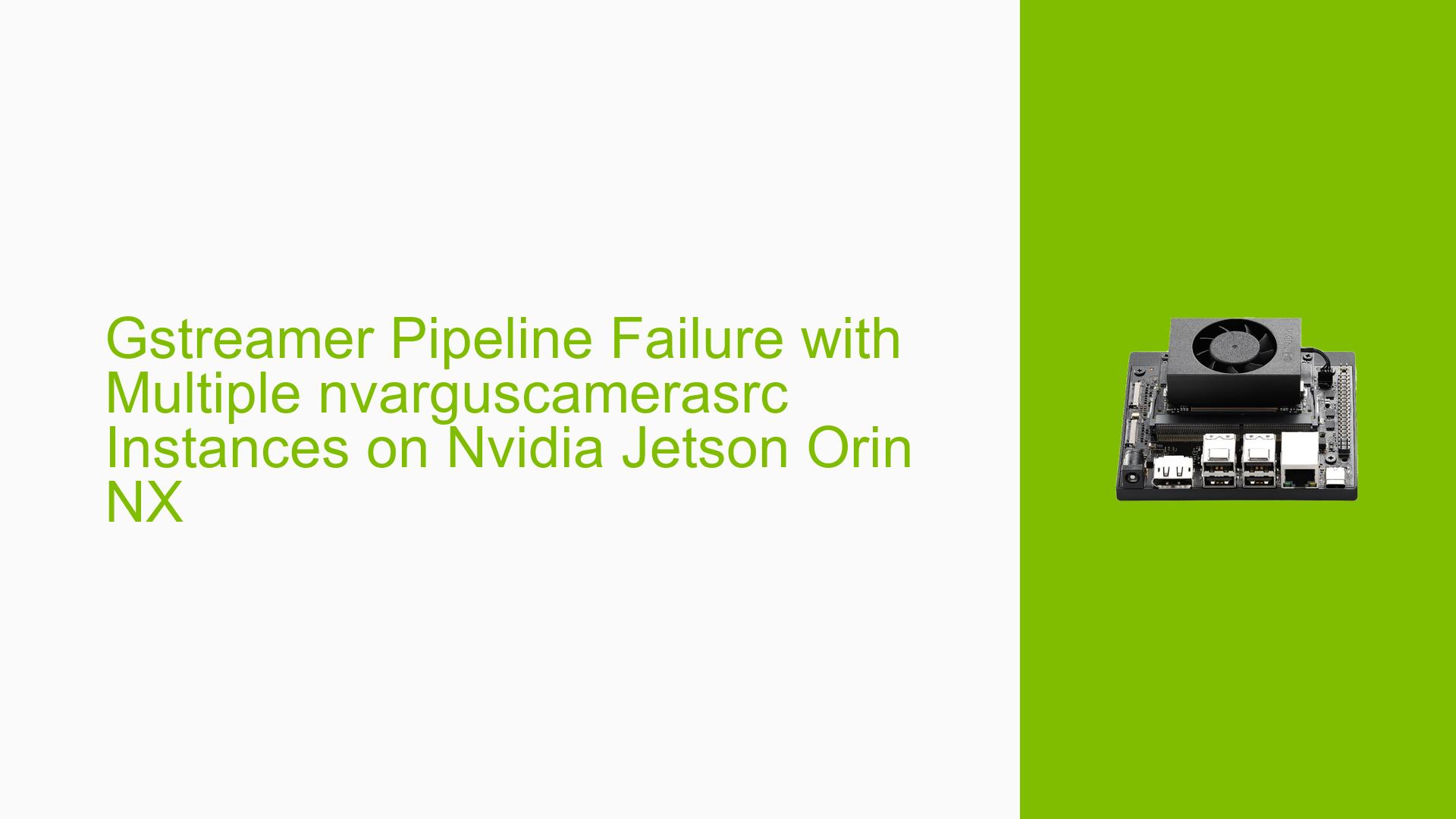Gstreamer Pipeline Failure with Multiple nvarguscamerasrc Instances on Nvidia Jetson Orin NX
Issue Overview
Users of the Nvidia Jetson Orin NX development board are experiencing difficulties when attempting to run multiple camera streams simultaneously using the nvarguscamerasrc GStreamer element. Specifically, the issue occurs when trying to use more than two nvarguscamerasrc instances in a single GStreamer pipeline. While two camera streams work as expected, adding a third or fourth stream results in only two sensors starting, with the selection of active sensors appearing to be random.
The problem manifests when using the following GStreamer pipeline:
gst-launch-1.0
nvarguscamerasrc sensor-id=0 ! 'video/x-raw(memory:NVMM), width=(int)1920, height=(int)1080, format=(string)NV12, framerate=(fraction)30/1' ! cammux.sink_0
nvarguscamerasrc sensor-id=1 ! 'video/x-raw(memory:NVMM), width=(int)1920, height=(int)1080, format=(string)NV12, framerate=(fraction)30/1' ! cammux.sink_1
nvarguscamerasrc sensor-id=2 ! 'video/x-raw(memory:NVMM), width=(int)1920, height=(int)1080, format=(string)NV12, framerate=(fraction)30/1' ! cammux.sink_2
nvarguscamerasrc sensor-id=3 ! 'video/x-raw(memory:NVMM), width=(int)1920, height=(int)1080, format=(string)NV12, framerate=(fraction)30/1' ! cammux.sink_3
nvstreammux name=cammux width=1920 height=1080 batch-size=8 batched-push-timeout=-1 !
nvmultistreamtiler rows=2 columns=2 width=1920 height=1080 !
nvvidconv flip-method=0 !
"video/x-raw, format=(string)I420" !
jpegenc quality=85 ! "image/jpeg" ! rtpjpegpay mtu=1400 pt=96 !
udpsink host=192.168.13.211 port=5001 sync=false async=false
Users report that all four cameras work correctly when run individually or when using v4l2-ctrl commands. However, the issue persists when attempting to use multiple nvarguscamerasrc instances simultaneously.
Possible Causes
-
Device Tree Configuration: The device tree may not be properly configured to support multiple camera streams simultaneously, particularly for the CSI interfaces.
-
Resource Contention: There might be conflicts in hardware resource allocation when multiple camera streams are initiated concurrently.
-
Driver Limitations: The current camera driver implementation may have limitations in handling multiple camera streams simultaneously.
-
MIPI CSI Lane Configuration: The MIPI CSI lane configuration might not be optimized for multiple camera streams.
-
Argus Camera API Issues: There could be limitations or bugs in the Argus camera API when dealing with multiple camera streams.
-
GStreamer Plugin Constraints: The nvarguscamerasrc GStreamer plugin may have constraints or bugs when handling more than two instances.
-
Power Management: Insufficient power delivery or management could lead to issues when multiple cameras are active.
-
Firmware or Software Version Incompatibility: The current firmware or software version may not fully support the desired multi-camera configuration.
Troubleshooting Steps, Solutions & Fixes
-
Verify Individual Camera Functionality:
- Test each camera individually using the following command:
gst-launch-1.0 nvarguscamerasrc sensor-id=X ! 'video/x-raw(memory:NVMM),width=1920, height=1080, framerate=30/1, format=NV12' ! nvvidconv ! 'video/x-raw(memory:NVMM),format=I420' ! fpsdisplaysink text-overlay=0 video-sink=fakesink sync=0 -v - Replace X with the sensor ID (0, 1, 2, 3) and verify that each camera works independently.
- Test each camera individually using the following command:
-
Check Device Tree Configuration:
- Review the device tree configuration, particularly the sections related to camera and CSI interfaces.
- Ensure that all four cameras are properly defined and that the CSI lanes are correctly assigned.
- Verify that the
num-lanesproperty is set correctly for each camera (2 in this case). - Double-check the
lane-polaritysettings for each camera.
-
Inspect MIPI CSI Configuration:
- Confirm that the MIPI CSI configuration supports the simultaneous use of all four cameras.
- Verify that the CSI lanes are properly assigned and do not conflict with each other.
-
Update Software and Firmware:
- Ensure that you are using the latest L4T (Linux for Tegra) release compatible with your Jetson Orin NX.
- Update all relevant drivers, especially those related to the camera subsystem.
-
Analyze System Logs:
- Check system logs for any error messages or warnings related to camera initialization or CSI interfaces.
- Use the following command to view relevant logs:
dmesg | grep -i camera
-
Investigate Resource Allocation:
- Monitor system resources while running multiple camera streams to identify any bottlenecks or resource exhaustion.
- Use tools like
top,htop, ornvidia-smito monitor CPU, GPU, and memory usage.
-
Test with Simplified Pipeline:
- Create a simplified GStreamer pipeline that only initializes the camera sources without additional processing:
gst-launch-1.0 nvarguscamerasrc sensor-id=0 ! fakesink nvarguscamerasrc sensor-id=1 ! fakesink nvarguscamerasrc sensor-id=2 ! fakesink nvarguscamerasrc sensor-id=3 ! fakesink - This can help isolate whether the issue is with camera initialization or downstream processing.
- Create a simplified GStreamer pipeline that only initializes the camera sources without additional processing:
-
Check Power Management:
- Ensure that the power supply is adequate for running multiple camera streams simultaneously.
- Monitor power consumption and thermal conditions during operation.
-
Investigate Driver Behavior:
- Enable verbose logging for the camera driver to gain more insight into the initialization process.
- Add debug prints in the driver code, particularly in the
ar0234_probefunction and CSI initialization routines.
-
Consult Nvidia Developer Resources:
- Check the Nvidia Developer Forums for similar issues or post a detailed description of your problem.
- Review the Jetson Linux Developer Guide for any specific multi-camera setup requirements or limitations.
-
Analyze Trace Logs:
- Use the
trace-cmdtool to capture and analyze detailed system traces during camera initialization and operation. - Focus on CSI and VI (Video Input) related events in the trace logs.
- Use the
-
Test Alternative GStreamer Elements:
- If possible, try using alternative GStreamer elements like
v4l2srcinstead ofnvarguscamerasrcto determine if the issue is specific to the Nvidia Argus camera API.
- If possible, try using alternative GStreamer elements like
If the issue persists after trying these steps, it may be necessary to contact Nvidia support or consult with the Jetson developer community for more specialized assistance. The problem might require a deeper investigation into the interaction between the camera driver, CSI subsystem, and GStreamer plugins on the Jetson Orin NX platform[1].
